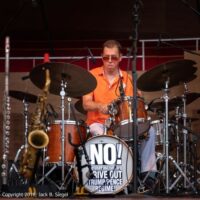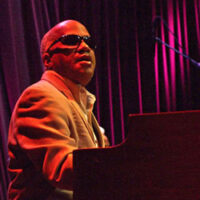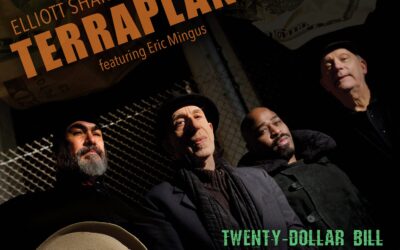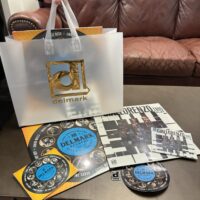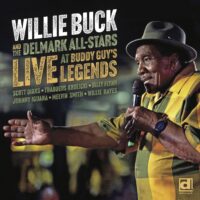No Events
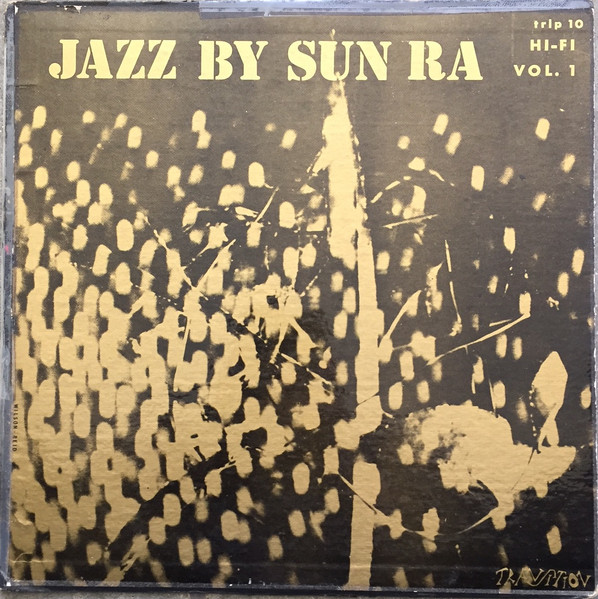
Sun Ra Arkestra @ Constellation, Chicago

 Home in internet of the Sun Ra Arkestra directed by Marshall AllenCopyright 1999-2023 El Ra Records |

In the half-between world,
Dwell they: The Tone Scientists
In notes and tone
They speak of many things…
The tone scientists:
Architects of planes of discipline
Mathematically precise are they:
The tone-scientists
CURRENT MEMBERS
 In some far off place In some far off placeMany light years in space I’ll wait for you Where human feet have never trod Where human eyes have never seen I’ll build a world of abstract dreams And wait for youThere’s a 29 minutes interview with Sun Ra (Detroit TV, 1981) at http://www.dangerousminds.net/comments/sun_ra_on_detroit_tv_1981/A BEAUTIFUL ESSAY BY STEFANY ANNE GOLBERGIn the Egyptian section of the Penn Museum stands a man. He is next to a 12-ton sphinx and is wearing a multicolored dreamcoat. His beret shimmers; a red cape hangs about his shoulders. “Planet Earth can’t even be sufficient without the rain, it doesn’t produce rain, you know,” he tells the camera. “Sunshine…it doesn’t produce the sun. The wind, it doesn’t produce the wind. All planet Earth produces is the dead bodies of humanity. That’s its only creation.” The man pauses and slides his hand across the sphinx. “Everything else comes from outer space. From unknown regions. Humanity’s life depends on the unknown. Knowledge is laughable when attributed to a human being.”• The birth of Herman Poole Blount on May 22, 1914 was, for him, the least significant of all his births. Blount begat Bhlount and Bhlount begat Ra and Herman begat Sonny and Sonny begat Sun. Sun Ra left Alabama for Chicago and Chicago for Saturn, until he never quite understood how he got to planet Earth in the first place. The name ‘Ra’ — the Egyptian god of the sun — brought him closer to the cosmos. Each rebirth erased the one before it, until Sun Ra’s past became a lost road that trailed off into nothingness. The past was passed, dead. History is his story, he said, it’s not my story. My story, said Sun Ra, is mystery. Sun Ra lived life between ancient time and the future, in something like the eternal now. He told people he had no family and lived on the other side of time. Rebirth might not be the right word for the journey that Sun Ra took. Awakening is more precise, like how the ancient Egyptians were awakened. As Jan Assaman wrote in Death and Salvation in Ancient Egypt, to be a person in ancient Egypt meant to exercise self-control. In sleep, a person is dissociated from the self. The sleeping person, then, is powerlessness, like a dead person. But the awakened one is a person risen.A great one is awakened, a great one wakes, Osiris has raised himself onto his side; he who hates sleep and loves not weariness, the god gains power…Sun Ra believed that the whole of humanity was in need of waking up. He wanted to slough off old ideas and habits, brush off sleepy clothing and shake off drowsy food. Because present time mattered little to Sun Ra, they say he rarely slept. Even as a child, he would spend all his time playing the piano or composing. “I loved music beyond the state of liking it,” he once said. Sun Ra was just as obsessed with books — you couldn’t see the walls of his room for the books. Books contained words and the words held a secret code that, if unraveled, revealed truths about human existence. He read the ancient texts of Egyptians and Africans and Greeks, the works of Madame Helena P. Blavatsky (with whom he shared the initials H.P.B), Rudolph Steiner, P.D. Ouspensky, James Joyce, C.F. Volney, Booker T. Washington. He read about the lost history of the American Negro and studied the origins of language. Sun Ra knew Biblical scripture better than any preacher, read Kabbalah concepts and Rosicrucian manifestos. Through these texts Sun Ra learned it was possible for the chaos of human knowledge to be ordered. Theosophy, relativity, mathematics, physics, history, music, magic, science fiction, Egyptology, technology — all were keys to a unified existence. Ideas and music carried a reclusive black boy from Birmingham and transported him into outer space. But the most important idea Sun Ra learned from all his reading, from all the knowledge he acquired, is how puny knowledge is in the face of the unknown. We need the unknown, Sun Ra said, in order to survive.Sun Ra abolished sleep from his “so-called life”, wrote biographer John Szwed, “just as he had come to do without the distractions of drugs, alcohol, tobacco, women.” Sun Ra didn’t want to be sidetracked by time like so many Earthly humans, spending half their lives in a stupor of slumber. In Gurdjieff, Sun Ra read that man exists in habit, but could be awakened from his slumber with sacred songs and dances. Sun Ra vowed to live every moment in anticipation, and he would do so through jazz. Jazz was the music of the restless, the awakened. Anybody could play music on the downbeat and think, “Everything is beautiful, ’cause I’m going to heaven when I die.” But peace is not an option for the fiery awakened. “Play some fire on it,” Sun Ra would tell his musicians. “If you’re not mad at the world, you don’t have what it takes.”In jazz, unity could emerge — even as individual notes seemed in disarray and rhythms seemed uncountable. Jazz demanded discipline and precision, but also an open mind. “A lot of things that some men do… come from somewhere else,” Sun Ra said, “or they’re inspired by something that’s not of this planet. And jazz was most definitely inspired, because it wasn’t here before.” Jazz was the road to a mystical experience, a sort of reasoned ecstasy. It was the music of elsewhere.•”I didn’t find being black in America to be a very pleasant experience,” said Sun Ra, “but I had to have something, and that something was creating something that nobody owned but us.” African-Americans had always been a secret society within greater American society, with their own music, their own language, their own rituals. This secret history could be an asset for African-Americans in the Space Age to come. African-Americans could re-invent their past and create a futurist Utopia, perhaps on a planet other than Earth, which seemed to Sun Ra unbearably steeped in chaos and confusion.Sun Ra called his band the Arkestra, though it went far beyond the limits of a band. The Arkestra was Sun Ra’s grand Gesamtkunstwerk, a total work that crossed the boundaries of art and life for Sun Ra and his musicians. It was Sun Ra’s little Utopia. The name Arkestra itself was an allusion to the Ark of the Covenant. “A covenant of Arkestra,” said Sun Ra, “it’s like a selective service of God. Picking out some people. Arkestra has a ‘ra’ at the beginning and the end. Ra can be written as ‘Ar’ or ‘Ra,’ and on both ends of the word it is an equation: the first and the last are equal…. In the middle there is ‘kest,’ which equals ‘kist,’ as in ‘Sunkist’…I read that in Sanskrit ‘kist’ means ‘sun’s gleam.’ This is why I called my orchestra ‘Arkestra.’””Besides,” Sun Ra once said, “that’s the way black people say ‘orchestra.'”Arkestra performances were music, theatre, dance, philosophy. They combined the ancient and the radical future, African rhythms played with fists and synthesizers played with the elbows. Arkestra musicians followed Sun Ra’s style, wearing Egyptian headdresses and African robes and Mardi Gras beads. Onstage, they laughed and danced and walked arm in arm. Sun Ra wanted to show his audiences an expression of pure possibility. And yet the Arkestra was more for the musicians than the audience. Musicians lived together (for a long while in a building Sun Ra bought on Morton Street, in the Germantown area of Philadelphia) worked together, thought together. When they weren’t onstage, they were rehearsing. They played music in place of social activities, in place of sleep. The Arkestra breathed music together, abandoned themselves to it, like one single enlightened organism with Sun Ra as their guide.Sun Ra’s compositions were famously difficult, even for the most talented instrumentalists. Arkestra musicians tell stories of being baffled sometimes for months before they could hear music in the written notes. The intervals were mad, impossible. Sun Ra was patient though, often choosing musicians who were more intuitive than knowledgeable, who could be developed (intuitive people had more space in their minds). One could imagine the Morton Street building like a monastery, and Arkestra rehearsals akin to liturgical chant, with Arkestra players embodying the music through repetition until playing was an ecstatic experience. “Discipline and precision were nature’s ways, the ways in which the planets spun through space, by which the birds flew; and precision rather than confusion was the answer, discipline rather than freedom,” writes Szwed. Sun Ra once told an interviewer that his very reason for being on Earth (not being of Earth) was to be a teacher. People are free to think what they want, he said. They got their own minds. God just lets them go on and on and on. But people, he said, they don’t ask no questions.”If teenagers are lost,” Sun Ra told another interviewer, “it is because they have been fed upon the word freedom, not discipline.”In the documentary A Joyful Noise Arkestra musician James Jacson tells the story of his drum. There was a tree, Jacson says, right across the street from 5626 Morton Street. And one day this tree got hit by lightening. I had been needing a drum, Jacson says. Sun Ra suggested Jacson use some of the wood from this downed tree before the city carted it away. Jacson spent an entire summer working with the stump, hollowing it out, crafting it into a musical instrument. He carved a bas relief on the side, a verse out of the “Book of the Reawakening” (what Sun Ra called the Egyptian Book of the Dead). “I didn’t really know a lot about drumming,” Jacson says to the camera, “but Sun Ra, of course, showed me a whole ’nother idea about drumming.” Sun Ra named Jacson’s drum the Ancient Infinity Lightening Wood Drum. It was a sacred object of the simplest kind, carved from an accident of nature, by a man who came to understand its possibilities just by being with it.•In her novel The Grey World, written ten years before the birth of Sun Ra, Anglo-Catholic mystic Evelyn Underhill wrote, “It seems so much easier in these days to live morally than to live beautifully. Lots of us manage to exist for years without ever sinning against society, but we sin against loveliness every hour of the day.”This observation reminds me of Sun Ra (who, perhaps, had read this book, having read nearly every book on mystical and occultish things printed in the English language). There was no dearth of ideas in the hundred-odd years that spanned the mid-19th to the mid-20th century for how to improve the lot of African-Americans, how to lift them up and give them purpose with strong leadership and values, a new moral code. Sun Ra’s thoughts about the necessity for discipline and reason in African-American society were shared by a number of American intellectuals and spiritual leaders, from W.E.B. Du Bois to Elijah Muhammad. But discipline alone lacked, for Sun Ra, creative energy, vitality. When morality expressed itself in beauty, daily life had a little more of that mysterious, mystical quality to it, a quality Sun Ra was always searching for to conquer the “unpleasant” aspects of what it was to be human on Earth. Morality could make life sensible but beauty made life happy. Why wear only a black suit and tie when we have available to us all the colors of the rainbow?”All of my compositions are meant to depict happiness combined with beauty in a free manner,” Sun Ra wrote in The Aim of My Compositions. “Happiness, as well as pleasure and beauty, has many degrees of existence; my aim is to express these degrees in sounds which can be understood by the entire world…. The mental impression I intend to convey is that of being alive, vitally alive. The real aim of this music is to coordinate the minds of peoples into an intelligent reach for a better world, and an intelligent approach to the living future.”Where Washington and Du Bois, for instance, were products of the Enlightenment, Sun Ra was a Romantic, finding order in the laws of nature and the patterns of ancient history. Sun Ra’s intelligent romantic method, his intelligent reach for a better world, could have been expressed by Dostoevsky, who wrote in Notes From Underground:The characteristics of our romantics are to understand everything, to see everything and to see it often incomparably more clearly than our most realistic minds see it; to refuse to accept anyone or anything, but at the same time not to despise anything; to give way, to yield, from policy; never to lose sight of a useful practical object … to keep their eye on that object through all the enthusiasms and volumes of lyrical poems, and at the same time to preserve “the sublime and the beautiful” inviolate within them to the hour of their death, and to preserve themselves also, incidentally, like some precious jewel wrapped in cotton wool if only for the benefit of “the sublime and the beautiful.” … The romantic is always intelligent…What better way to preserve the sublime and the beautiful in a useful practical object than by creating a drum from a forgotten tree stump? Only in beauty could Sun Ra’s ideas resolve themselves, the way mathematics can only eventually resolve into song when it is part of everyday life.In 1979 the Arkestra put out an album called “Sleeping Beauty.” The first track on the album has the title “Springtime Again.” Sleep, for Sun Ra, was like a little death, just as it was for Sleeping Beauty. And yet Sleeping Beauty was never actually dead; she was just waiting to see the spring again. “I have to be like a little child,” he said. “I have to be totally sincere — to put my music out there and say take it or leave it.” Life, for Sun Ra, was not only a morality tale, but a fairytale too. TEXT FROM A 1989 PRESS KIT BY A&M RECORDSThe Differences Sometimes in the amazing ignorance I hear things and see things I never knew I saw and heard before Sometimes in the ignorance I feel the meaning Invincible invisible wisdom, And I commune with intuitive instinct With the force that made life be And since it made life be It is greater than life And since it let extinction be It is greater than extinction. I commune with feelings more than prayer For there is nothing else to ask for That companionship is And it is superior to any other is. Sometimes in my amazing ignorance Others see me only as they care to see I am to them as they think According the standard I should not be And that is the difference between I and them Because I see them as they are to is And not the seeming isness of the was. Sun Ra |


